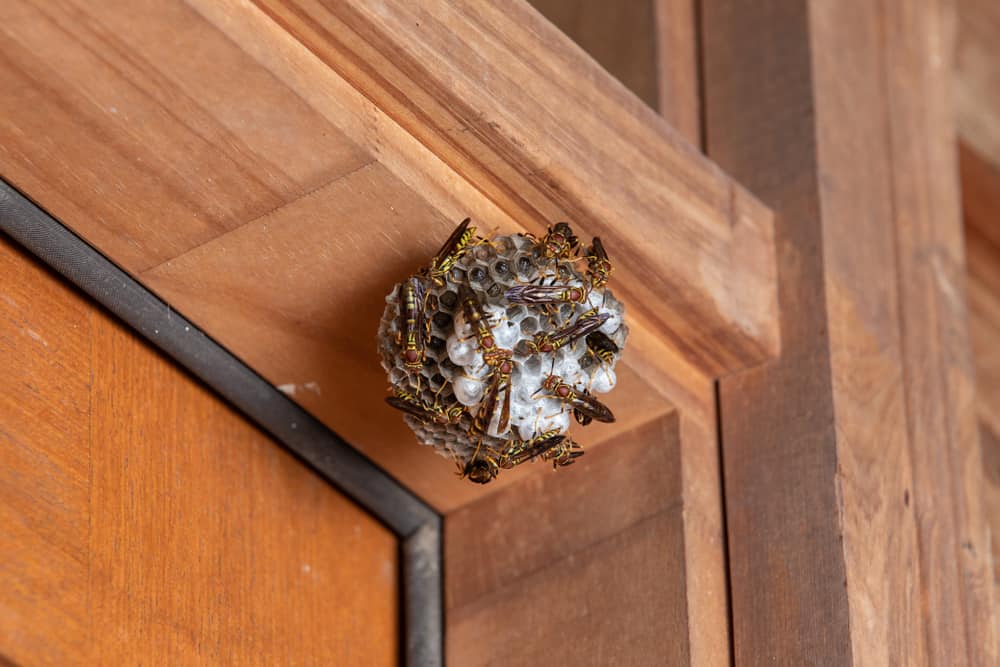Hornets and wasps are often confused, but they have distinctly different nests that make them easy to identify. Learning what kind of nest you’ve spotted will help you respond appropriately and understand the nature of what you’re dealing with.
In short, hornet nests are often much larger, set up mostly in tree branches or leaves, and have a paper-mache appearance. Wasp nests are smaller to keep their smaller colonies safe, have distinct hexagonal openings, and can be set up in nearly any sheltered space.
Knowing what you’re dealing with can help you make sure you’re not allergic to the flying stingers before dealing with them. It also clues you in on how many are zooming about, so keep reading to learn more about the differences and how you should respond.
Hornet Nests vs. Wasp Nests: The Basics
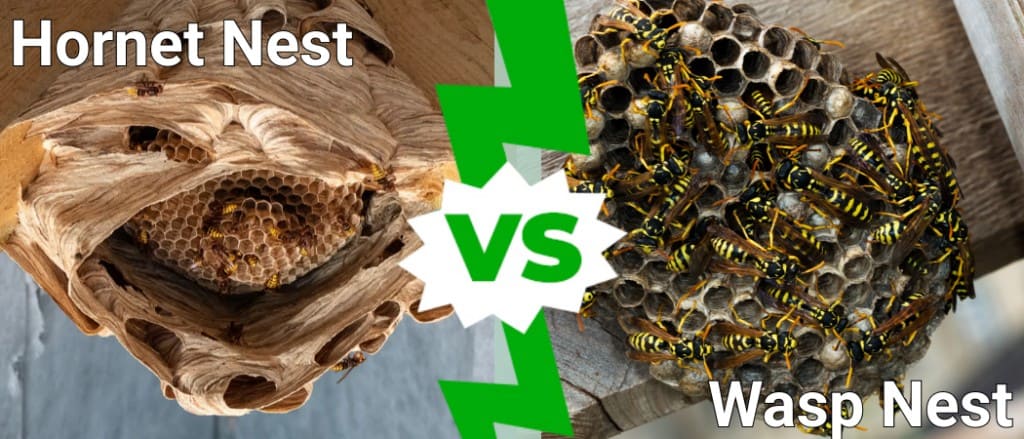
Credit: a-z-animals
Despite all the differences we will cover, hornets and wasps are pretty similar. Technically, hornets are also wasps, as wasp is an overarching category in which all stinging bugs are included.
(Most people are talking about paper wasps when they use the term, so that’s what we focus on in this article.)
All of these bugs have nests with a core intended for hatching eggs and raising their young. They’re usually non-confrontation, but will respond aggressively if threatened.
Both hornets and wasps are social insects. When they’re attacked or the nest is threatened, they will release a pheromone to prompt the others in the nest to attack.
This can be beneficial, and you may not want to remove them at all. Most nests only emerge in warmer months, around April/May, and only last the year. During this time, they will feed on pests like caterpillars, crickets, and flies, meaning they can protect a garden you have without charging for their pest-control services.
Other Flying Stingers to Watch Out For
Keep in mind that hornets and wasps aren’t the only flying stingers to watch out for. While all stinging bugs are in Hymenoptera order, there are several types around the globe.
The ones you’re most likely to come across include:
- Bees: more short and stout than others on the list; hives are usually less apparent and may even be in your attic or walls
- Yellow jackets: slimmer and longer bodied; usually create subterranean nests in abandoned rodent burrows
- Bald-faced hornets: not true hornets (more similar to yellowjackets); more aggressive and likely to attack without provocation; nest high in tree cavities
- Mud daubers: solid black or brown with a slender torso; unlikely to sting; solitary wasps that live in singular mud tubes
Bees are more difficult to remove and usually require a professional pest control service for complete removal (as well as beneficial relocation). Because yellow jackets and bald-faced hornets are so aggressive, we also recommend professional intervention.
Hornet Nests vs. Wasp Nests: What’s the Difference?
To tell the difference between hornet nests and wasp nests, pay attention to:
- The appearance of the insects you see flying around
- The general appearance of the nest
- The size of the nest
- Where the nest is located
These will tell you the most about whether you’re dealing with a hornet or a wasp infestation.
Appearance of Hornets or Wasps in the Area
Hornets are usually larger than wasps, although this can change depending on the specific breed you’re dealing with.
European hornets are the only true hornet in North America, the largest eusocial wasp native to Europe, and reach up to 1.5 inches (twice the size of most other hornets).
Asian Giant Hornets have been in the U.S. since 2019, and they have orangish heads, black bodies, and gray wings. They can reach a maximum of 2 inches, making them even more menacing.
On the other hand, wasps have a thinner waist with a triangular side profile. They’re usually black, red, or yellow, and they only grow an average of 1 inch long.
Nest Appearance
The nests, on the other hand, have distinctly different appearances.
Hornets make their nests by chewing up wood pulp and using the waste. Their saliva helps bind it together, and they can quickly create a large round or teardrop shaped nest.
Because they come from wood matter, the hornet nests are gray or born in color. They have a single entrance and 2 to 4 horizontal combs on the inside. The outside seems like they’ve created a paper-mache pinata, and it appears more sleek and uniform than the typical wasp nest.
Paper wasp nests are also made of wood and saliva, but they’re more likely to use scrapings from fences, logs, or yard furniture. They have a paper-like structure with hexagonal openings and no uniform cover.
The wasp nests start as a tiny golden ball, but they become more grayish brown and distinct as the construction progresses.
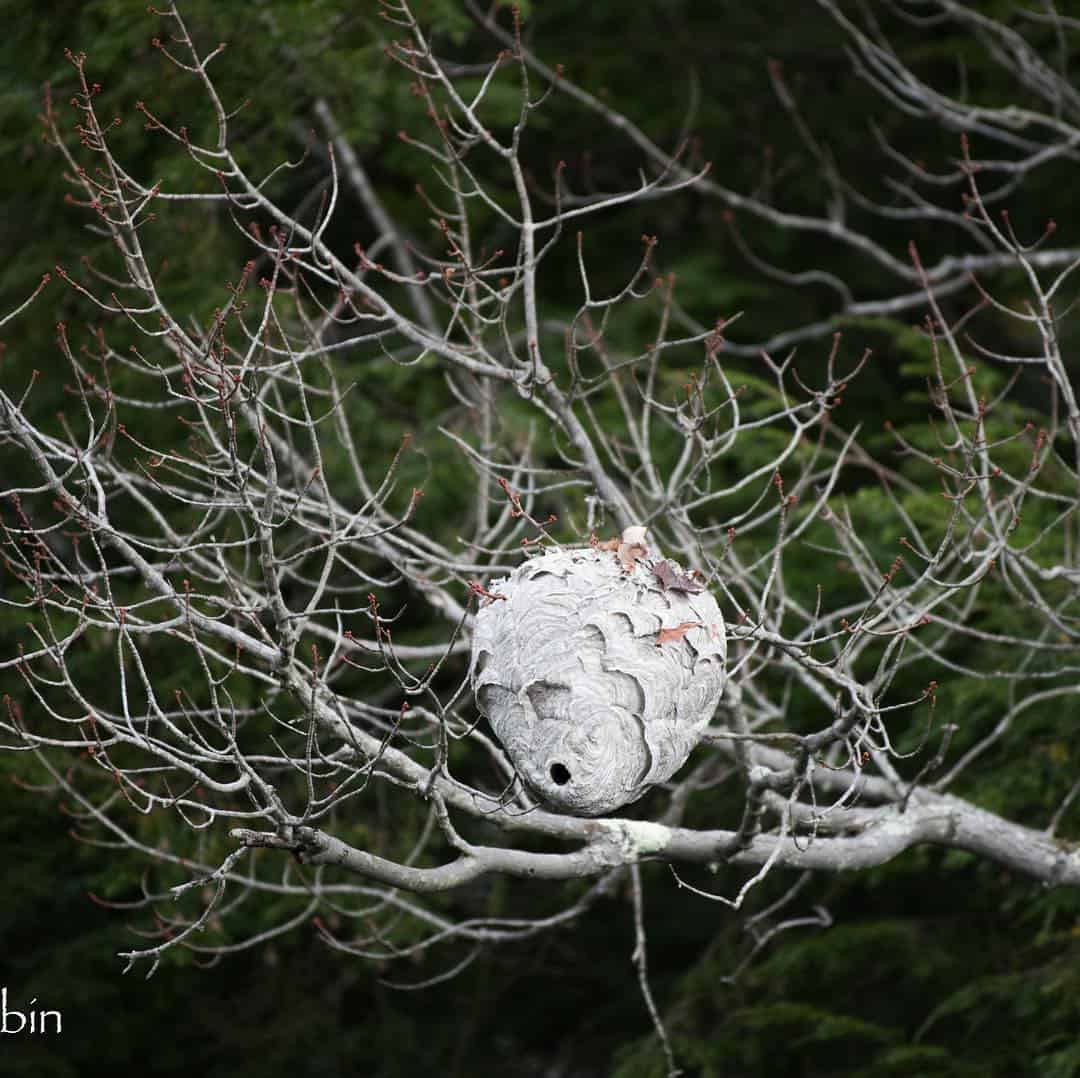
Credit: moosemanphotos
Nest Size
Hornet colonies are much larger than wasps, and they must have a suitable nest to accommodate everyone. Smaller hornet nests may only need to house 200 to 400 bodies, but the larger families reach 700 workers easily.
Because of this, it’s not uncommon to see a hornet nest the size of a basketball. For security, they will have a single nest entrance near the bottom.
Wasp nests are much smaller. They start as a small walnut-sized home created by the queen in the spring. By late summer, the number of wasps in the swarm increases and the nest makes space for everyone.
Usually the wasp nests only need to accommodate 25 adults, but some swarms grow as large as 100 wasps or more in peak season.
Nest Location
The location of a hornet nest depends on the species you’re dealing with.
- European Hornets prefer voids in the walls, shrubs, and tree branches. They’re also known to set up under the siding of a house, in the rafters of an undisturbed attic, or in crawl spaces.
- Giant European Hornets make sure they’re as far from sunlight and moisture as possible
- Asian Giant Hornets build subterranean nests, either by confiscating tunnels dug by other animals or by creating their own near rotten tree roots
Paper wasps prefer more exposed areas, like tree stumps, eaves, or cavities within buildings. They can fit in smaller areas, and often take on the appearance of tiny umbrellas hanging from above.
Like hornets, other types of wasps prefer specific locations.
Cicada Killers prefer to move into trees that also shelter their prey, while Spider Wasps burrow into the ground. Mud Daubers build the singular tubal nests inside walls, barns, and garages. And you can probably guess where Digger Wasps prefer to nest.
How to Handle a Hornet or Wasp Nest: Preliminary Work
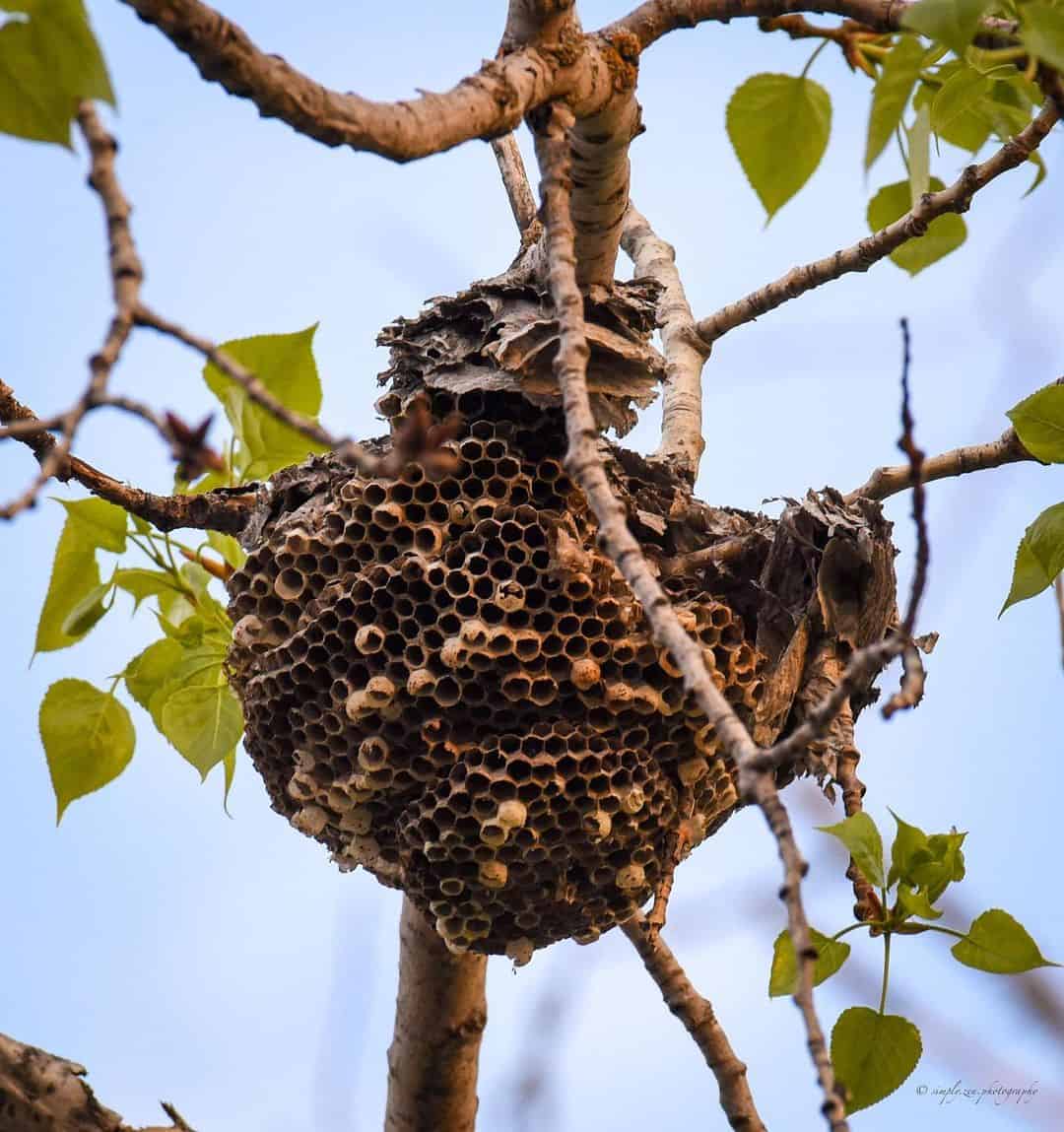
Credit: simply.zen.photography
You should first determine what type of nest you’re dealing with. This keys you in on:
- How big the nest is (and therefore which methods are most accessible)
- How many flying insects you should anticipate responding to your efforts
- Whether you’re allergic to their stings or not
Make sure everyone in your home knows about the nest so they can steer clear of the area, and do your best to keep windows and doors closed.
If possible, contact pest control professionals for the safest, quickest, and most efficient removal of the nest. If you choose to move forward with removal on your own, make sure you follow these guidelines closely and have someone ready to provide backup (or make an emergency phone call if needed).
Determine Need for Removal
You may not need to remove the nest. Most hornets and wasps will leave you alone as long as you leave them alone, so having a nest in a far off space that you don’t frequent isn’t necessarily a bad thing.
You may even find that the hornets and wasps are cutting down on harmful bugs around your greenery, making them a valuable asset to your home.
Make Sure You’re Not Allergic
Before you tackle the nest problem, it’s best to verify whether you’re allergic to the stinging insects or not. Even if you’ve been tested before, we recommend having an allergy test done at your doctor.
Allergies can pop up unexpectedly, and getting stung by a bug you’re allergic to is a great way to visit the inside of a hospital.
If it turns out you’re allergic, don’t feel any shame about turning it over to the professionals. At least you know how severe the issue is, and you can move forward more safely.
Heart Problems and Insect Stings
Even if you’re not allergic, these stings can be severe enough to cause serious damage to those with heart problems. Make sure you have no creeping issues, and reconsider DIY removal if your heart isn’t up to it.
Don Safety Gear and Attack At Night
Once you’ve set your mind on treating the issue at hand, you can move forward using one of the methods we’ve listed below.
Regardless of which method you choose, you should dress appropriately and plan to tackle the nest problem in the dark.
The more skin you have covered, the less likely you will be stung.
We recommend:
- Long sleeves (ideally a thick hooded sweater with tight bands at the wrists and bottom)
- Socks and boots
- Jeans (tucked into the socks and boots)
- Gloves
- Safety glasses
Make sure any holes for your arms, head, or legs are sealed off as much as possible to prevent accidently trapping the stinging insects under your clothes and against your skin.
Planning to attack at night means you will deal with them while they’re less active and aggressive. Both wasps and hornets are slow to react in the dark, meaning you’ll have more time to get to safety.
Methods for Removing Hornet or Wasp Nests
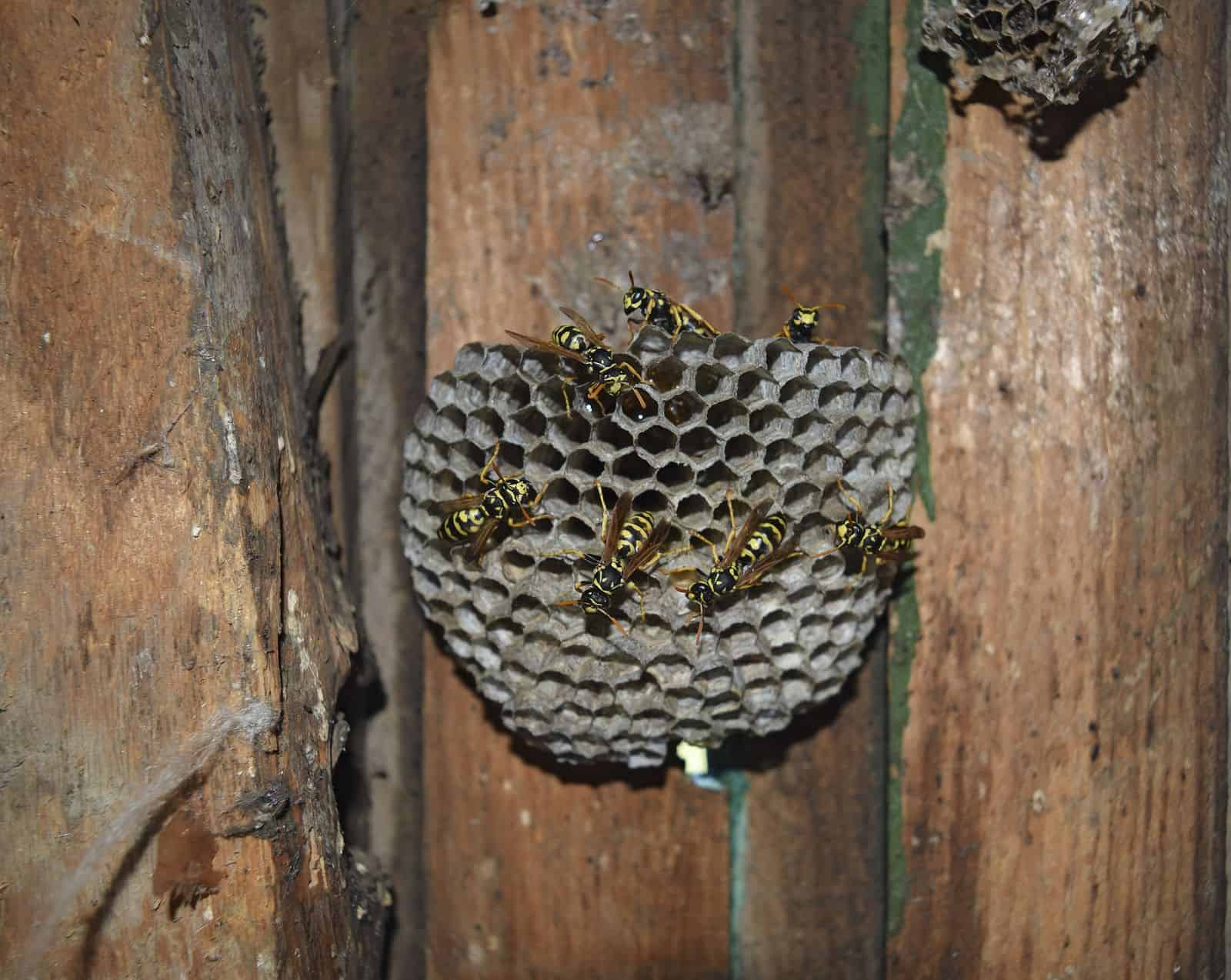
Credit: beemanbuzz
The most effective ways to remove hornet or wasp nests involve:
- Pesticide spray
- Insecticide dust
- Dish soap and water spray
- Drowning
The method you choose will depend on the type of hornets or wasps you’re dealing with as well as what you’re comfortable with.
1. Hornet and Wasp Spray
Commercial aerosol sprays are preferred for a number of reasons.
They’re not only effective in killing the insects, but they spray long enough to keep you far from the nest as you attack.
Make sure you use a spray intended for hornets and wasps, and follow the instructions on the can. Aim for the entrance as much as possible, then let the spray sit overnight. Watch over the nest for the next two days to make sure they’re all dead before you remove the nest.
You can also couple this method with the bucket of water method below for even more protection.
Make sure you wash any areas that the spray may have splashed onto, and wash your hands with soap and water after handling.
2. Dust
Insecticide dust is primarily used for subterranean hornet and wasp nests.
Sprinkle it on the nest entrance in the darker hours while wearing your protective gear, then leave them alone for the next few days. They will pick up what dust as they come and go, spreading it to other wasps as they socialize.
Insecticide dust should take out the nest in a day or two, but you may need to repeat once or twice. You can destroy the tunnels once they’re all gone.
3. Dish Soap and Water
A quarter cup of dish soap mixed with a liter of water will not be as effective as pesticide spray or dust, but it works in a pinch.
For hanging nests, you want to put the mixture in a hose-end spray bottle then spray the area for about 10 to 15 seconds. This keeps you far away and should provide enough power to penetrate the nest, possibly suffocating the hornets and wasps.
Ground nests are a bit more risky. Dump the mixture directly in the entrance, then high-tail it out of there.
4. Drowning
Drowning the nest in water is riskier, but it’s cheaper and definitely gets the job done. You can use this as a follow-up to other methods to make sure every last stinger is out of commission.
Fill a large bucket with water and then set it underneath, then use a large cloth bag ( such as a pillowcase) to quickly cover the nest. Secure the top with string or a zip tie, then submerge the cloth in the bucket.
Secure the lid, then leave it for as long as you need to feel comfortable. Most will drown overnight, but there’s no harm in leaving it for longer.
Conclusion
Identifying what type of nest you have is only half the battle. In most cases, you will want to respond promptly and efficiently to make sure no one in your home is stung by a hornet or wasp.
Once you’ve removed the nest, we recommend hanging up a fake hornet nest or using essential oils to keep them from returning to the area. This ensures you will not need to repeat the process again in a year.
Let us know if you have any other questions about hornet nests, wasp nests, or dealing with these stinging fliers.
